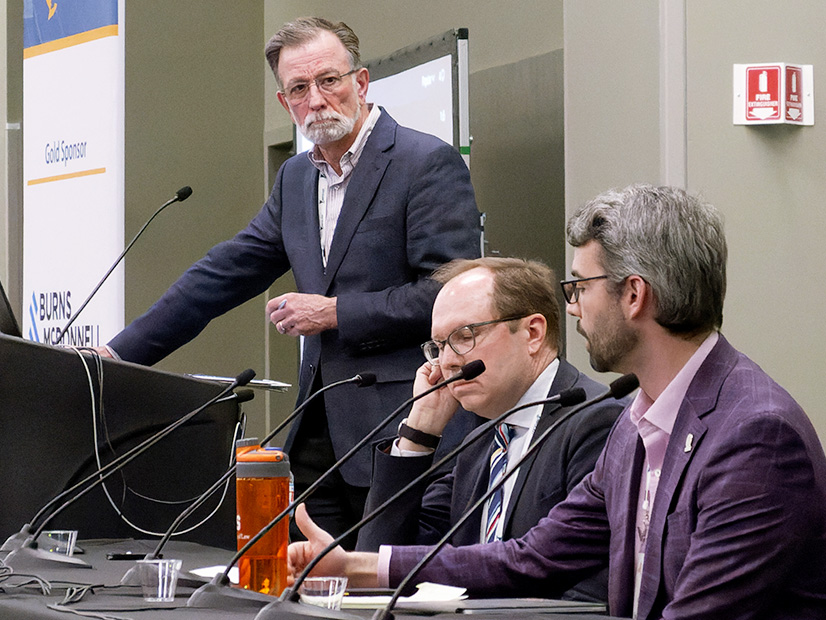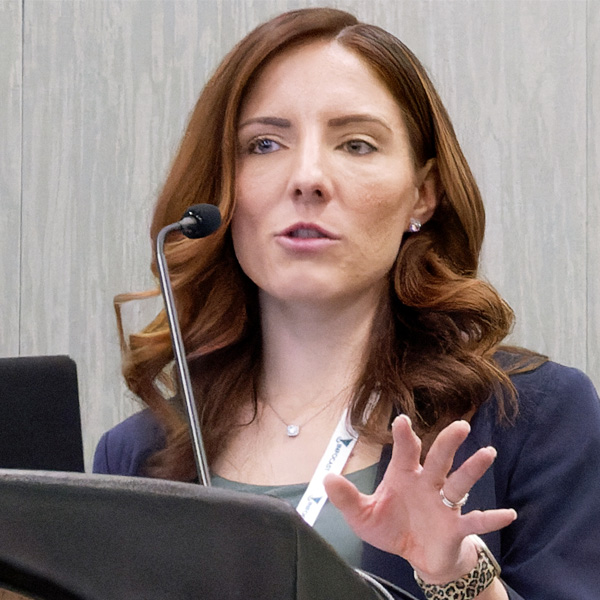
ALBANY, N.Y. — Natural gas is in the crosshairs of New York’s decarbonization drive, but the fossil fuel will likely remain indispensable to the state’s energy portfolio for years to come, even as it contributes to climate change.
So, until the transition is accomplished, it is critical to leverage every molecule of gas as efficiently as possible, panelists argued during the April 4-6 NY Energy Summit.
 Chris Stolicky, N.Y. Department of Public Service | © RTO Insider LLC
Chris Stolicky, N.Y. Department of Public Service | © RTO Insider LLCThe state’s Climate Leadership and Community Protection Act (CLCPA) codified decarbonization goals, including 70% renewable energy generation by 2030 and zero-carbon electricity by 2040, while New York City’s Local Laws 97 and 154 effectively will ban installation of new gas systems in buildings starting in 2024.
And as New York’s Tale of Two Grids notes, upstate regions’ power needs are almost entirely supplied by renewable resources, while downstate is run almost exclusively by fossil fuels, particularly natural gas.
“New York was a pioneer in using gas, and so it is no surprise that it is now pioneering aggressive climate goals that reduce methane,” Chris Stolicky, chief of gas system planning and reliability at the New York Department of Public Service, said during his “Future of Natural Gas” presentation.
“The catch to this is that if you lose gas service, it’s a very big deal” because it “delivers three times as much BTU content and energy to customers than other resources,” so if New York wants to “offset that heating load with electric versus natural gas, [the state] needs to deliver three times as much energy,” Stolicky said.
Cooperation is Key
Natural gas is targeted for its global warming effects, both from methane leaks before combustion and carbon dioxide emissions during combustion. But as Stolicky noted, New York continues to rely on it for more than 40% of its energy needs, and the United States has become the largest gas producer in the world.
On top of that, there was a widespread push to replace oil-burning equipment with cleaner-burning gas until relatively recently. New York now “wants to stop that train … and find a better way to generate energy because there’s a lot of emissions and impacts,” Stolicky said.
This is not expected to be easy, particularly in the densely populated downstate regions.
Therefore, “as the last firewall” between policymakers and consumers, Stolicky and his team act as the “gas ISO for New York,” and look to balance system reliability and affordability with environmental concerns by bridging cooperation between stakeholders.
“A well planned and strategic transition of the gas system will require coordination across multiple sectors,” he said.
Stolicky said an integrated planning process involving customers, NYISO and state agencies enables gas utilities to forecast peak demand, keep costs low without compromising reliability, and educate ratepayers about an industry whose operations influence their daily lives but has “not always been transparent.”
Stolicky said his agency remains committed to New York’s decarbonization, but there are challenges ahead and stakeholders need to “buckle down and work hard collectively” to overcome them and bring the state to its net-zero goals.
New York utilities argue they are well positioned to tackle these challenges because of their existing network of assets, extensive knowledge about grid operations, and ability to invest in new technologies to replace natural gas.
Leverage Every Gas Molecule
During the Transmission & Distribution Plans & Investment panel, moderated by RTO Insider’s Rich Heidorn Jr., Christopher Raup, vice president of energy policy and regulations at Consolidated Edison (NYSE: ED), and Tom Vaccaro, director of transmission business development at National Grid (NYSE: NGG), made their case for why utilities are well positioned to help New York’s transition.
Both panelists emphasized how state utilities committed to collaboratively decarbonize through the Coordinated Grid Planning Process (CGPP). They said that the plan will maintain reliability, expedite renewable development and deployment, keep utilities competitive and not hurt ratepayers.
The details are not finalized, however. (See NY Utilities’ Proposed Grid Planning Process Gets Tepid Reception.)
Leaving “no stone unturned” the CGPP plan offered by New York’s utilities would operate via a “meaningful iteration” process that integrates stakeholders while “striking a balance between coming up with new information and getting [interconnection] processes done as quickly as possible so that [stakeholders] can iterate again,” said Vaccaro.
New York has a “high voltage” problem, said Vaccaro, explaining that the grid is “running at 345 kV, which is very high compared to what you would typically see for bulk power at the utility distribution level.” The utilities’ CGPP proposal would solve this issue by integrating transmission planning at all grid levels so utilities “can build things for customers that are less expensive.”
Additionally, after Superstorm Sandy, utilities have actively worked with state agencies and other stakeholders to develop climate modeling that predicts extreme weather impacts on the electric system, according to the panelists.
Utilites “take lessons from climate change vulnerability studies and reflect those in the infrastructure that [they] build out and operate,” said Raup.
“All of us utilities have a shared [decarbonization] vision with the state and NYISO,” and the cooperation initiated by the CGPP “hopefully removes some roadblocks and expedites these processes,” Vaccaro said.
Vaccaro fielded a question about how the state’s utilities are strategizing fossil fuel infrastructure as the state presses to make it obsolete.
“We’re not going to be able to do everything at once” but will “leverage the remaining life out of our gas system” since New York’s electrification may face future challenges, he said. Utilities plan to “use [gas] equipment for as long as [they] can before transitioning out.”
Raup added that hydrogen could be used in existing gas infrastructure after 2040 and “could help fill the valleys when the sun isn’t shining, or the wind isn’t blowing.”
Hydrogen: A Natural Gas Substitute?
Hydrogen is still in development as a clean and economical energy source but likely has a future in New York as the technology improves.
Green hydrogen was frequently cited “as a tool to reduce greenhouse gas emissions” in the Climate Action Council’s Scoping Plan.
 Pete Budden, Natural Resources Defense Council | © RTO Insider LLC
Pete Budden, Natural Resources Defense Council | © RTO Insider LLCMore recently, the state, as part of the seven-state Northeast Regional Clean Hydrogen Hub, applied to be designated as a national hub for hydrogen.
“I envision hydrogen infrastructure across the U.S. with pipelines in different municipalities all shifting their waste to go to hydrogen gasification,” Joe Bushinsky of the Regional Hydrogen Infrastructure Development at Mitsubishi said during the Hydrogen Hubs: Financing, Revenue Structures & Incentives panel.
Introducing this technology to scale “is a challenge, but it is doable” he said. “There is a market for [hydrogen] but a lot of things have to fall into place.”
One potential opportunity, Bushinsky said, “is to take waste and instead of putting it into landfills and waiting years for it to produce renewable natural gas to instead move it to syngas to produce hydrogen.”
Pete Budden, a green hydrogen advocate with the Natural Resources Defense Council, tempered expectations, saying hydrogen “is an incredibly useful and important tool in our decarbonization toolbox,” but “can be a distraction from more cost-effective solutions.”
“Hydrogen is an indirect greenhouse gas,” Budden said, referring to how atmospheric leakages prevent methane decay, so it “should not land into gas distribution networks” because that blending is “where we are most worried about leaks.”
 Jessica Waldorf, N.Y. Department of Public Service | © RTO Insider LLC
Jessica Waldorf, N.Y. Department of Public Service | © RTO Insider LLCMichel Delafontaine, president of Alternative Aviation Fuels, agreed, saying “blending is not going to be the project that drives these infrastructure demands” and hydrogen’s best application will be decarbonizing transportation or energy-intensive industries such as steelmaking.
But he pointed out that some utilities, SoCal Gas for example, have been studying how to safely blend hydrogen into their gas networks.
“There are opportunities for these infrastructure projects” to help gas utilities decarbonize since it can “act as an enabler” to defer consumer costs by expanding capacity, Delafontaine said.
Moderator Michelle Detwiler, executive director of the Renewable Hydrogen Alliance, added that Hawaii Gas has been “blending hydrogen into their syngas residential distribution systems at about 20% for 46 years with no deleterious effects.”
The push to phase out natural gas as quickly and completely as possible in New York is countered by the need to maintain its infrastructure as long as needed.
Jessica Waldorf, chief of staff and director of policy implementation at the Department of Public Service, touched on this during her presentation. “There are many paths to achieving the outcomes envisioned in the climate act,” she said, and a “one-size-fits-all approach is unlikely to meet the diversity of needs across the state.”
